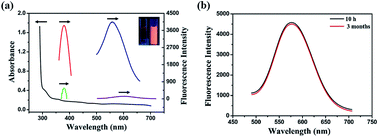One-pot synthesis of enhanced fluorescent copper nanoclusters encapsulated in metal–organic frameworks†
Abstract
The encapsulation of Cu nanoclusters (Cu NCs) in metal–organic frameworks (MOFs) would improve the properties of Cu NCs. So far, these composites were reported by a two-step synthesis process. In this work, a facile one-pot synthesis of hybridization of glutathione (GSH) protected Cu NCs (Cu NCs@GSH) and MOF-5 (Cu NCs@GSH/MOFs) composites was reported for the first time. The results of UV-vis, TEM, XPS and SEM proved Cu NCs@GSH were distributed homogeneously over the entire MOF structure. The fluorescence intensity of Cu NCs encapsulated in MOF-5 was enhanced about 35-fold owing to the confining scaffold of the MOF and the stability was extended from 3 days to 3 months. Cu NCs@GSH/MOFs composites exhibited strong orange fluorescence and the emissions could change between blue, orange and red as they were partially reversible in different pH environments. This one-pot synthetic strategy could be extended for the encapsulation of fluorescent Ag NCs in MOFs as well. As-prepared Cu NCs@GSH/MOF-5 composites had high stability, and were easily recycled by centrifugation in aqueous solution, therefore, it would be utilized to develop a reusable sensor for detection of metal ions in the future.



 Please wait while we load your content...
Please wait while we load your content...